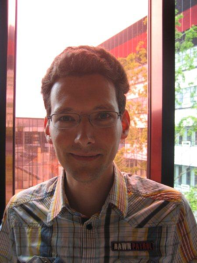Tailoring pulses for coherent Raman microscopy
Promotion date: 20. July 2012
Promotor: Prof. dr. Jennifer Herek
Assistant promotor: Dr. ir. Herman Offerhaus
| This thesis describes improvements of chemical selectivity and contrast in coherent Raman scattering (CRS) spectroscopy and microscopy. CRS techniques, such as stimulated Raman scattering (SRS) and coherent anti-Stokes Raman scattering (CARS), provide chemical information of a sample based on the vibrational resonances in molecules. These resonances occur at characteristic frequencies related to the mass of the atoms and the strength of the bonds between the atoms. From the presence of these resonances the presence of compounds of interest can be inferred. In conventional narrowband CRS microscopy, the contrast is based on a narrow frequency range, covering only a single vibrational resonance. In samples with many compounds, vibrational resonances can overlap significantly and contrast based on a single resonance may not be sufficient to separate different compounds. Furthermore, some implementations suffer from a non-resonant background that is generated even in the absence of vibrational resonances. This non-resonant background can overwhelm the resonant signal. The CRS techniques described in this thesis excite multiple vibrational resonances simultaneously. Spectral phase shaping of the excitation light is used to influence the interferences between the different resonances and excitation pathways. In this way selective and background-free images are obtained. |
In what way is your research application oriented?
CRS microscopy has been used in biomedical imaging for over ten years now. It is also used in for example the food industry, to study the distribution of fat in various food products, pharmaceutical development and agrochemical research.
My approach is special in two ways, I believe. In conventional CARS, narrowband picosecond laser pulses are used to excite a single vibration within a molecule. In our approach we replace one of the picosecond lasers with a femtosecond laser. This laser produces very short pulses containing many different wavelengths, which allows us to excite multiple vibrations simultaneously.
In complex samples, the vibrations of different compounds can overlap significantly and it becomes increasingly difficult to separate them. By modifying the temporal structure of the excitation pulse, intervening signals from other compounds are actively suppressed. In this way we can improve the chemical selectivity.
The shaping of the excitation pulse can be considered analogous to composing a musical piece. The different wavelengths in a broadband laser pulse can be thought of as different notes or keys on a piano. A very short, unshaped laser pulse can then be represented by simultaneously hitting all the keys of the piano, resulting in a short burst of sound. By changing the order and timing with which different notes are played, different melodies or differently shaped laser pulses can be created. The idea is to find a melody that only one of the compounds in the sample responds strongly to. We construct these pulse shapes using an evolutionary algorithm. This strategy proved to be very successful.
Did you have some nice publications?
Several articles were published over the course of my PhD project, for example in Optics Express; the Journal of the Optical Society of America B; the Journal of Raman Spectroscopy; and Optics Communications. Furthermore, I have presented our work at both national and international conferences, such as the SPIE Photonics West in San Francisco. This summer I will be presenting at the ECONOS conference in Aberdeen.
How did you develop individually as a researcher during the thesis project?
Choosing to do a PhD project was a logical step for me after completing my master thesis project, as I want to pursue an academic career. After completing a PhD project there are still many possibilities to move into industry, so it leaves plenty of career options open.
I acquired a lot of skills during the past four years in optics research. I learned to be more critical during the research process itself, for example by performing additional tests to check obtained results. Also I learned that applied research comprises a complex interaction between theory, numerical simulations and experiments.
What are your future plans?
I plan to find a post-doc position abroad, looking for a topic which is interesting to me at a good university in a nice city. The experience gained in doing a project abroad is of value in building a scientific, academic career. That is my main goal at this moment.
What, in your opinion, is important for Mesa+ to stay successful in future?
Mesa+ facilitates a lot of exposure to the research of other groups within the university and from other groups outside the university, for example through the annual Mesa+ day and the Mesa+ colloquia. There is also a lot of collaboration between the optics groups here at the university through the strategic research orientation Applied NanoPhotonics (ANP), led by dr. Pepijn Pinkse. This includes monthly meetings, as well as shared projects between different research groups. I believe the collaborations with research groups both inside and outside this university are of added value and contribute significantly to the success of Mesa+.

